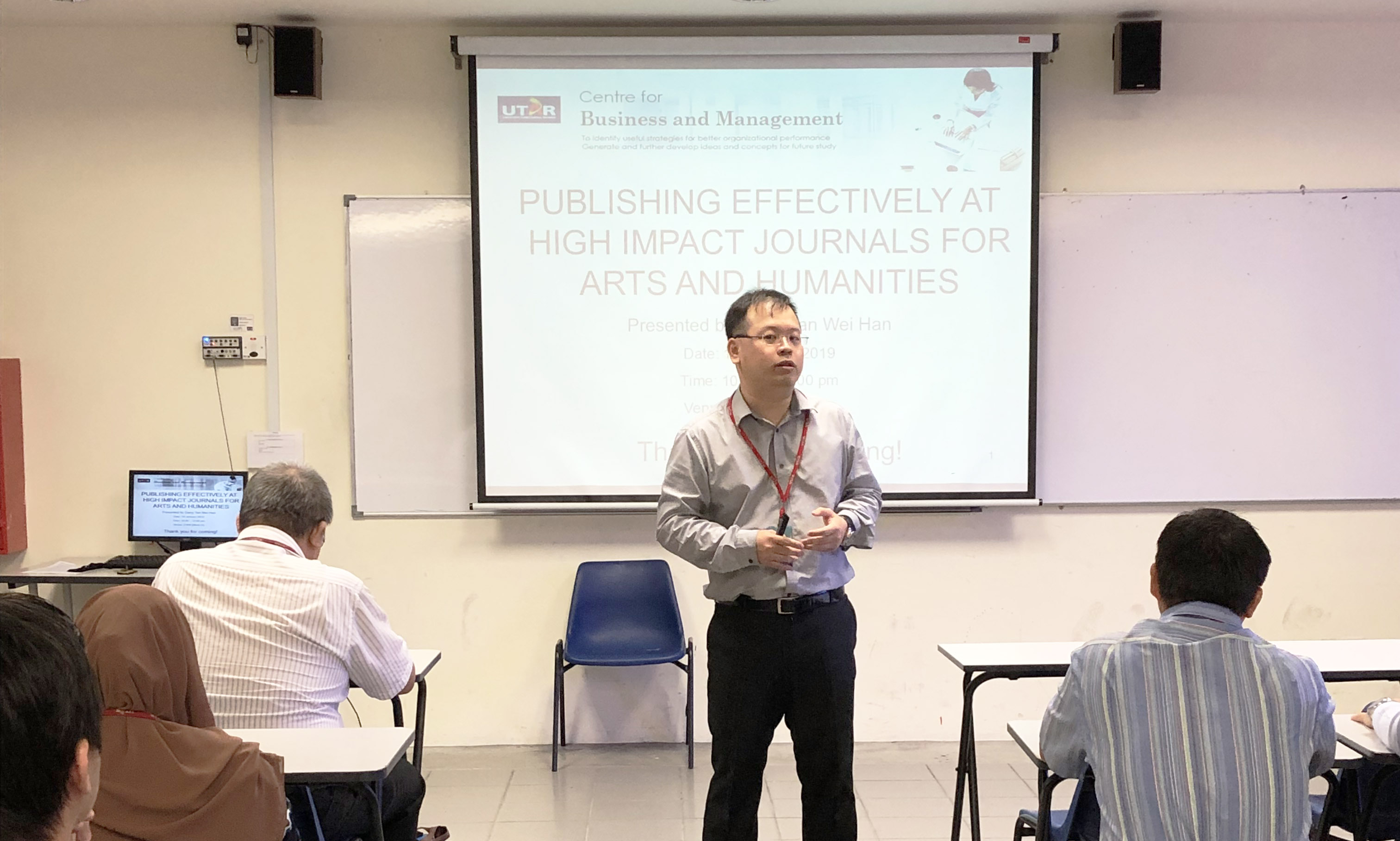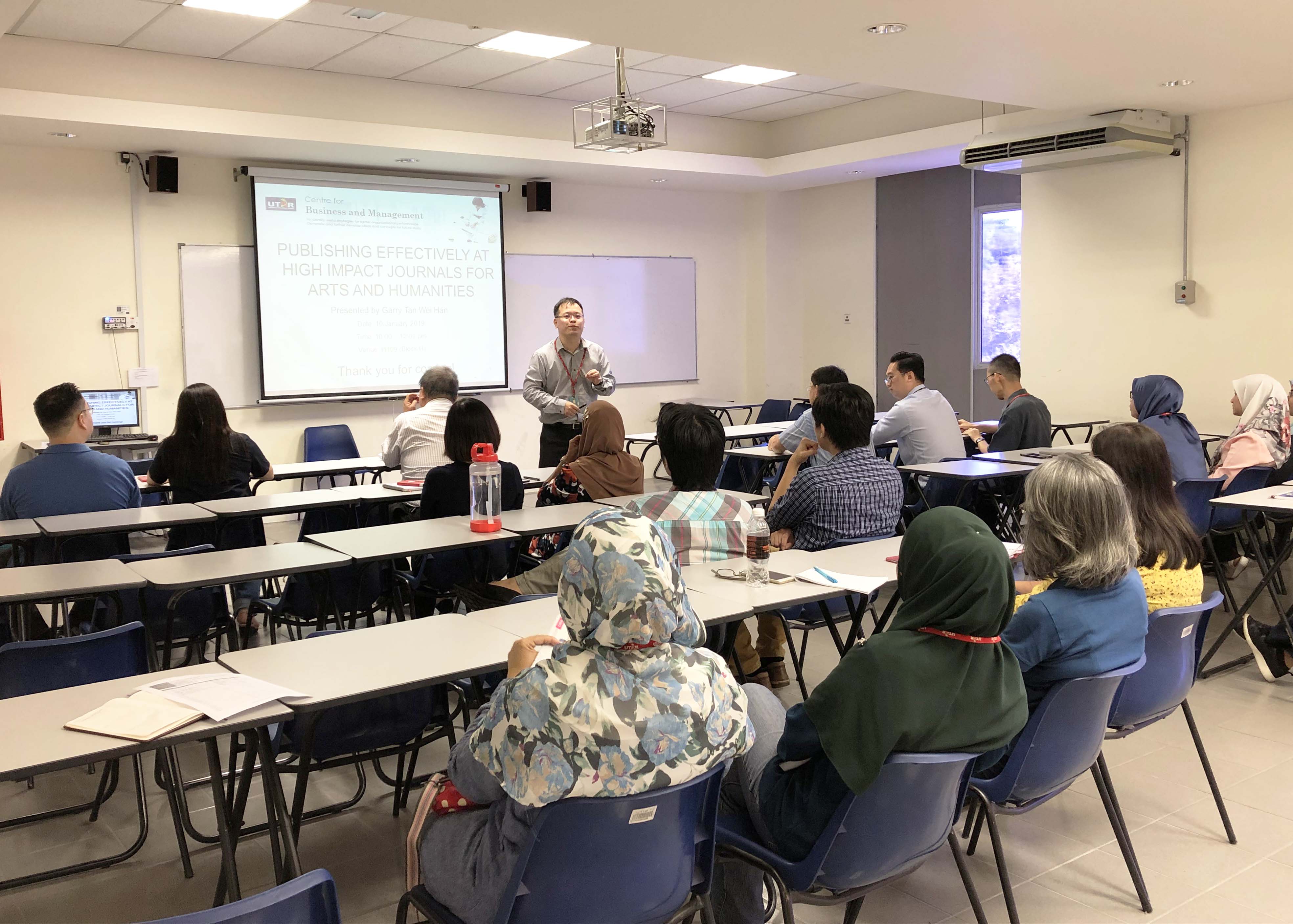


Tan (centre) with the participants at the end of the talk
In the pursuit of research excellence, UTAR academics have produced multiple award-winning researches that have benefited the society. To further strengthen the quality of research, academics are also constantly participating and engaging with each other through research talks, forums, sharing session and dialogue session to expand knowledge and ideas.
At the recent research talk titled “Publishing Effectively at High Impact Journals for Arts and Humanities: What Matters Most”, invited speaker and senior lecturer Garry Tan Wei Han enlightened participants on how to effectively publish their journals. The talk was organised by the Centre for Business and Management (CBM). Present at the talk were CBM Chairperson Assoc Prof Dr Lee Voon Hsien, academics and postgraduate students. The aim of the talk was to share a basic understanding on how to write and publish effectively, while also addressing problems to prevent ill-prepared and poorly written journals.
Tan spoke on three areas in relation to research; which were reasons to publish journals, the how-tos of writing good journal papers and the process of submitting journal papers. The reasons for publishing journals, according to Tan, are certainly many, but the most common reasons for academics to publish journals were such as applying for promotion or advancing their career, sharing of knowledge with other fellow academics, and to receive certain recognition for the work they have done. He also enlightened participants with some of the research criteria set by various institutions of different countries for academics to be promoted.
In the second part of his talk on writing good journal paper, Tan started by breaking down the format and structure of research papers. Beginning with the creation of title, Tan advised participants to use creative titles to capture the attention of editors and reviewers. He pointed out that newspaper titles are often very creative, hence easily captures the readers. With that concept in mind, Tan told participants to refer to top journals and newspapers for ideas to form creative titles.
“Use killer titles and keep it concise, accurate and informative. Your titles should also be related to your research papers with words that readers might be searching for. Avoid using abbreviations and conventional titles that begin with “A study of..” or “An investigation of..”. If you study the journals in Emerald, the top cited journals usually have short titles,” said Tan.
In ensuring that the participants have the full idea of a good abstract written, Tan advised the participants to refer to journals from Emerald because the format of Emerald journals is well structured. He also emphasised the importance of using appropriate keywords in their journal. This ensures their article to be easily, quickly and accurately found online within the top five searches. He also highlighted the importance of keywords being reflected in the journal titles. Tan also listed a few items that would allow participants to easily identify the quality of certain journals by referring to the Association of Business Schools (ABS) journal list or Australian Business Deans Council (ABDC) journal. Tan explained that rankings in the ABS list were standardised as 4* (a world elite journal); 4 (a top journal); 3 (a highly regarded journal); 2 (a well-regarded journal); and 1 (a recognised journal). Meanwhile, the ABDC list groups the journals into A* (best or leading journal in its field); A (highly regarded journal in the field or subfield); B (well-regarded journal in the field or subfield); C (recognised journal).
Other items that participants can look into when determining the quality of the journal included, double-blinded peer review, good reputation, turn around time and members of the editorial board. Also, check it is Cabell-indexed, Scopus-Indexed, or Clarivate Analytics Indexed with high impact factor.
Tan continued highlighting the importance of the introduction containing more updated citations, and the discussion which reflects the originality of the journal. Towards the end of the talk, Tan also spoke on the need for participants to understand the review process, the editor’s requirements and actions taken to resubmit their journals.

Tan giving an introduction about the talk

Tan casually interacting with participants before the talk
Tan is an award-winning researcher, who is currently a senior lecturer at Faculty of Business and Finance. Tan is also an active reviewer and has reviewed over 70 articles in the past one year, which also earned him the “Top 1% of Reviewers” in the “Assorted” category in “Publons 2018 Global Peer Review Award” and the recent “Outstanding Contribution in Reviewing” certificate.
Read more about his prior achievements here:
FBF academic's research recognised as "Most Downloaded Article"
Winning Publons Peer Review Award again
Winning the Top Cited Author Award
Lecturer receives another Outstanding Reviewer Award
© 2019 UNIVERSITI TUNKU ABDUL RAHMAN DU012(A).
Wholly owned by UTAR Education Foundation Co. No. 578227-M LEGAL STATEMENT TERM OF USAGE PRIVACY NOTICE